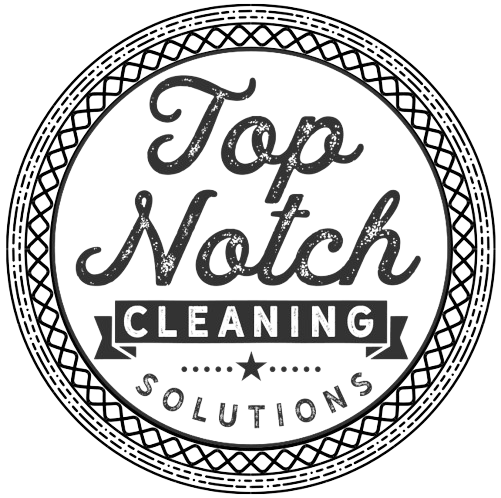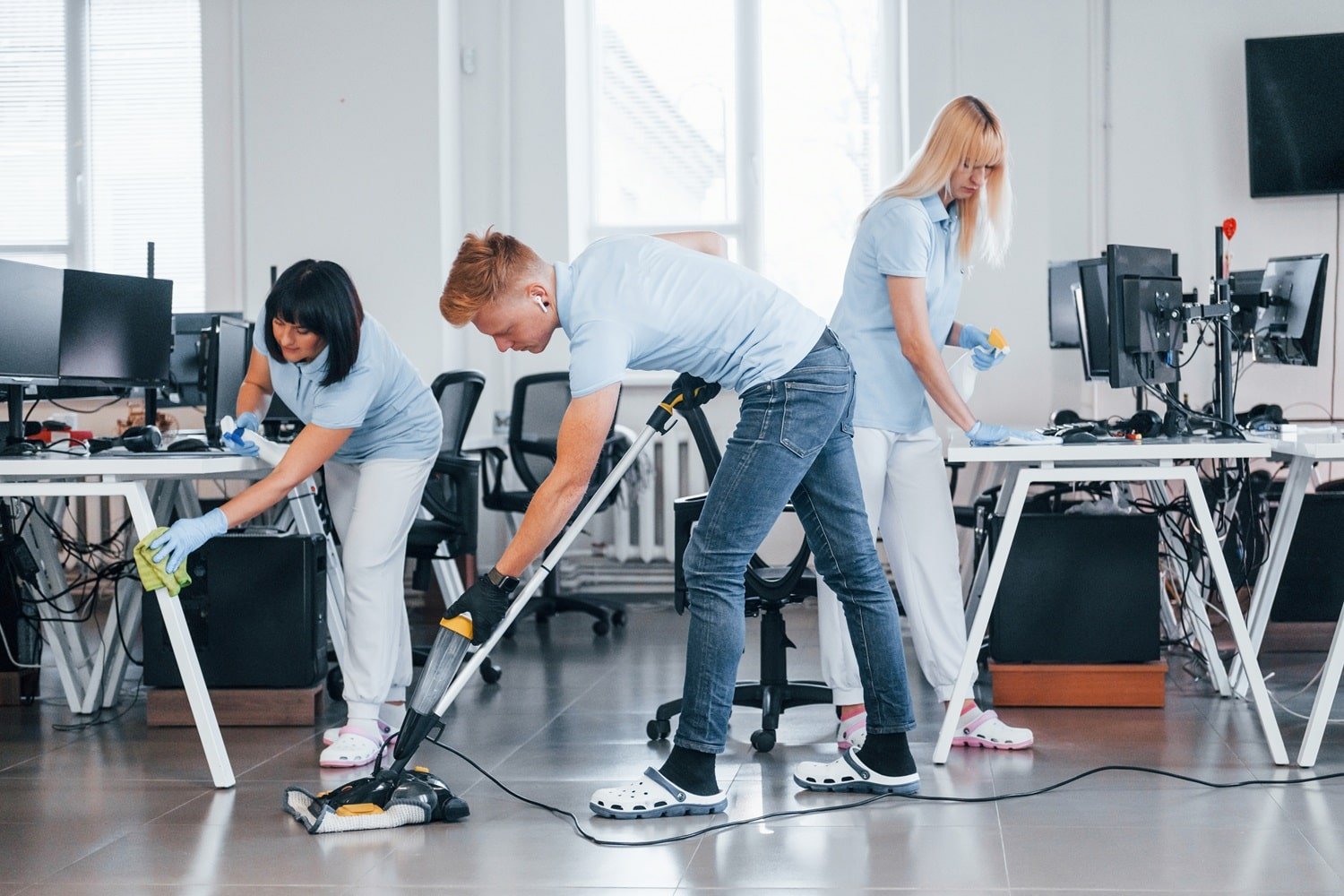Setting the Foundation for Office Cleaning

A clean office promotes hygiene and boosts productivity. It’s imperative to adopt systematic cleaning practices to maintain an environment conducive to work.
Understanding the Importance of Cleanliness and Hygiene
Cleanliness in an office is paramount for the health and comfort of everyone using the space. It directly affects workers’ health, as a clean environment reduces the spread of germs and illness. Studies show that clean offices can decrease employee sick days and increase concentration. Also, cleanliness in the office reflects on the company’s image, with clients and visitors gaining a positive impression of a business that values hygiene and a tidy workspace.
Best Practices for Office Cleanliness:
-
Regular Desk Cleaning: Each employee should be responsible for keeping their desk area clean, reducing the accumulation of clutter and dust.
-
Disinfection of High-touch Areas: These include doorknobs, elevator buttons, and shared equipment which should be sanitized frequently.
-
Proper Waste Disposal: Bins should be emptied and cleaned regularly to avoid odors and maintain hygiene.
Formulating a Cleaning Schedule and Checklist
A well-structured cleaning schedule ensures that all aspects of office cleaning are addressed regularly and efficiently. This schedule should outline daily, weekly, and monthly tasks to maintain cleanliness standards consistently. Checklists are indispensable as they provide a clear framework for the cleaning staff and ensure that no area is overlooked.
Sample Office Cleaning Schedule:
| Frequency | Task |
|---|---|
| Daily | Dusting workstations, vacuuming floors |
| Weekly | Cleaning bathrooms, wiping windows |
| Monthly | Deep carpet cleaning, air vent maintenance |
Essentials for a Cleaning Checklist:
- Daily Tasks: Such as disinfecting surfaces, emptying bins, and tidying common areas.
- Weekly Responsibilities: Such as thorough cleaning of restrooms and kitchen areas.
- Special Focus Areas: Monthly deep cleans of upholstery and electronic equipment.
By understanding the importance of a hygienic workspace and implementing a detailed cleaning regimen, offices can ensure a healthier, more productive environment for both staff and visitors.
Best Practices for Cleaning and Disinfecting

Effective office cleaning and disinfecting involve both routine actions and focused efforts on areas that frequently come into contact with hands. Using the right chemicals and techniques can maintain a healthy workplace environment.
Everyday Tactics for Maintaining Office Cleanliness
For daily maintenance, cleaning staff should start with a thorough dusting of all surfaces, followed by a comprehensive sweep of the floors. Once dust and debris are removed:
-
Disinfecting: Apply EPA-approved disinfectants to all non-porous surfaces, especially in common areas. Let the chemical sit for the required dwell time to ensure efficacy.
-
Sanitization: Focus on sanitizing porous materials, such as upholstered furniture, by using appropriate sprays that both clean and disinfect.
Note: It’s important to always wear gloves and follow the manufacturer’s guidelines for safe use of cleaning chemicals.
Strategies for Dealing with High-Touch Areas
High-touch areas in an office include door handles, elevator buttons, light switches, and phones. To effectively reduce the spread of germs:
-
Regular Disinfection: These areas should be disinfected multiple times throughout the day using disinfectant wipes or spray.
-
Protocol for Use of Disinfectant: Implement a precise protocol dictating the frequency and method of cleaning for high-touch surfaces.
| High-Touch Area | Disinfection Frequency | Method |
|---|---|---|
| Door Handles | Every 2 hours | Wipes/Spray & Cloth |
| Elevator Buttons | Hourly | Wipes |
| Light Switches | Every 2 hours | Wipes/Spray & Cloth |
| Phones | After each use | Wipes |
Tip: Keep disinfectant wipes readily available at shared stations to encourage employees to wipe down surfaces after use.
Equipment and Supplies Management

Effective management of cleaning equipment and supplies is crucial for maintaining a systematic and efficient cleaning regimen. This encompasses selecting appropriate products and ensuring they are stored correctly to preserve their quality and prolong their lifespan.
Selecting the Right Cleaning Supplies and Equipment
When choosing cleaning supplies and equipment, it’s imperative to consider the specific needs of the office environment. The selection process should involve:
- Durability: Opt for equipment that is known for its longevity and ability to withstand regular use.
- Efficiency: Choose products that maximize cleaning efficiency, such as multi-surface cleaners or high-functioning vacuum cleaners.
- Safety: Ensure that all cleaning supplies are non-toxic and meet safety standards, to safeguard the health of office inhabitants.
- Environmentally Friendly Options: Incorporate green cleaning products that are biodegradable and eco-friendly, reducing the office’s carbon footprint.
The following table outlines examples of essential supplies and their attributes:
| Equipment/Supply | Attribute | Importance |
|---|---|---|
| Microfiber cloths | High absorbency | Reduces cleaning time |
| Mops | Ergonomic design | Enhances user comfort |
| Disinfectants | Broad-spectrum effectiveness | Ensures proper hygiene |
| HEPA filter vacuums | High filtration level | Improves air quality |
Storage Solutions for a Clutter-Free Environment
Proper storage solutions are key to maintaining an orderly space and ensuring that cleaning supplies are easily accessible. Here are important considerations for storage:
- Accessibility: Store frequently used items in an easily reachable location to streamline the cleaning process.
- Organization: Use shelving units and labels to categorize supplies, thus avoiding clutter and confusion.
- Safety: Keep hazardous products in a secure location, ideally under lock and key, to prevent accidental misuse.
- Maintenance: Regularly check the storage area to keep it tidy and discard any outdated or damaged items.
Implementing these practices ensures that the office remains a clean and productive workspace.
Specialized Office Areas and Their Specific Needs

Specialized office areas such as break rooms and restrooms require tailored cleaning strategies to maintain hygiene and employee health. Each area demands attention to different fixtures and appliances to ensure a thorough clean.
Ensuring a Clean and Safe Break Room
Break rooms are communal spaces where employees eat and relax, making cleanliness crucial for health. Surfaces should be disinfected daily, especially tables, countertops, and microwave handles. A regular cleaning checklist should include:
- Microwave: Daily interior wipe-downs with a disinfectant to prevent food splatter accumulation. Weekly deep cleaning is recommended.
- Refrigerator: Weekly clearing and cleaning of shelves with a food-safe cleaner, and a comprehensive monthly cleaning from the inside out.
- Ventilation: Monthly checks and cleaning of vents to ensure air quality remains high, reducing the spread of odors and potential allergens.
Restrooms: Maintaining High Standards of Sanitation
The restrooms require meticulous and frequent cleaning due to their constant use and the potential for germ spread. A strict cleaning schedule should encompass:
- Toilets and urinals: Scrubbed with a disinfectant at least twice daily.
- Sinks and faucets: Wiped down with an antibacterial cleaner multiple times per day.
- Ventilation: Regular cleaning of vents and ensuring proper function to remove odors and maintain air circulation.
Regular stocking of soap, paper towels, and toilet tissue is also imperative in a restroom to maintain sanitation standards.
Health, Safety, and Employee Wellness

Maintaining a clean office environment plays a pivotal role in the health, safety, and overall wellness of employees. This not only contributes to a reduction in workplace illness and injury but can also enhance employee morale and productivity.
Promoting a Culture of Health and Safety
Communication: Employers should regularly inform and train employees on the importance of maintaining a clean workplace. Clear guidelines and the provision of necessary equipment and materials support a health and safety-first approach.
- Responsibility: Every employee must understand their role in keeping the workspace clean. Designate teams or individuals for specific cleaning tasks.
Routine Checks: Regularly scheduled health and safety audits can identify potential hazards before they cause harm.
- Emergency Preparedness: Have clear action plans and ensure all staff know what to do in the event of a workplace accident or emergency.
Improving Indoor Air Quality and Worker Well-being
Proper Ventilation: Offices should ensure that their heating, ventilation, and air conditioning (HVAC) systems are routinely inspected and maintained. This is crucial for circulating fresh air and removing pollutants.
- Air Filtration: High-efficiency air filters can capture airborne contaminants, significantly improving indoor air quality.
Green Cleaning Products: Usage of eco-friendly cleaning products helps to reduce exposure to harsh chemicals that can affect both the indoor environment and employee health.
- Plants: Incorporating indoor plants can aid in purifying the air and enhancing the aesthetic of the office space, contributing positively to employee morale.
By prioritizing health and safety through these practices, businesses can foster a healthy workspace that safeguards employee well-being and productivity.
Frequently Asked Questions
Effective office cleaning ensures a healthier, more productive work environment. Here are frequently asked questions concerning best practices in office sanitation.
What are the essential tasks to include in an office cleaning checklist?
An office cleaning checklist should include dusting, vacuuming, trash removal, and disinfecting common surfaces. Regular cleaning of electronics, restrooms, kitchens, and windows is also critical.
How can office cleaning routines be optimized for better efficiency?
Cleaning routines can be optimized by using a systematic approach, employing high-efficiency equipment, and scheduling tasks during low-traffic times. Training staff to follow a standardized process also increases efficiency.
What should be included in an office’s daily, weekly, and monthly cleaning schedules?
Daily cleaning schedules should cover tasks like disinfecting surfaces, tidying common areas, and spot cleaning. Weekly tasks may include thorough cleaning of restrooms and kitchens, while monthly schedules often consist of deep cleaning carpets, upholstery, and less frequently used areas.
Which environmentally friendly cleaning practices can be implemented in office settings?
Offices can implement green cleaning by using products with eco-friendly labels, reducing chemical usage, and adopting microfiber cloths and mops to minimize waste. Incorporating recycling programs and energy-efficient equipment are other strategies.
What are some effective bathroom cleaning protocols for office environments?
Effective bathroom cleaning protocols include daily disinfecting of high-touch areas, maintaining soap and paper dispensers, and regular deep cleaning to prevent mold and mildew buildup. Staying stocked with necessary supplies also maintains cleanliness.
How can the cleanliness of an office impact employee productivity?
A clean office can positively impact productivity by reducing illness-related absenteeism and creating a comfortable environment that boosts morale. Clutter-free and sanitized workspaces also support better concentration and efficiency.

